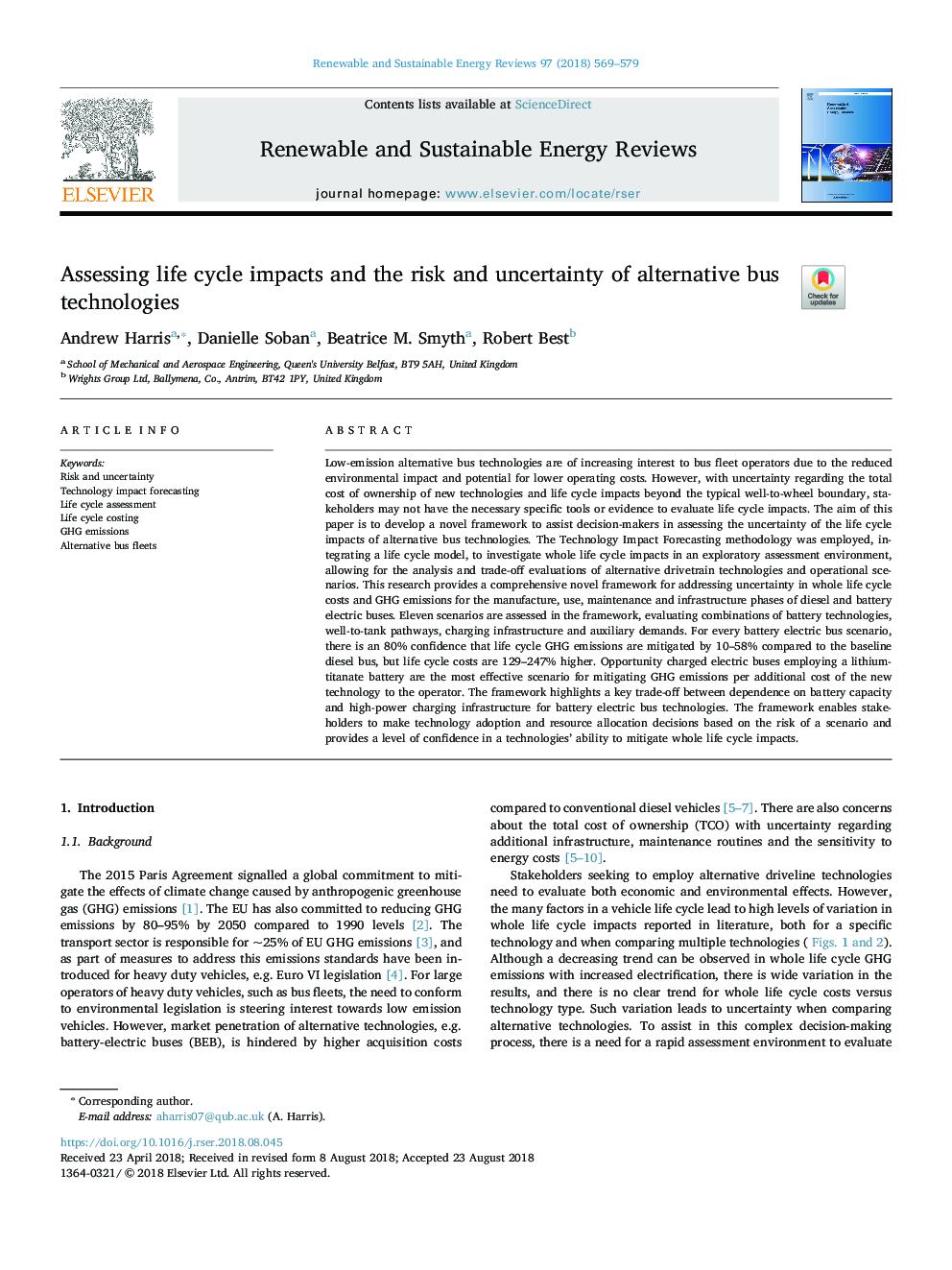| کد مقاله | کد نشریه | سال انتشار | مقاله انگلیسی | نسخه تمام متن |
|---|---|---|---|---|
| 11032113 | 1645686 | 2018 | 11 صفحه PDF | دانلود رایگان |
عنوان انگلیسی مقاله ISI
Assessing life cycle impacts and the risk and uncertainty of alternative bus technologies
ترجمه فارسی عنوان
ارزیابی اثرات چرخه زندگی و خطر و عدم اطمینان فن آوری های جایگزین اتوبوس
دانلود مقاله + سفارش ترجمه
دانلود مقاله ISI انگلیسی
رایگان برای ایرانیان
کلمات کلیدی
خطر و عدم اطمینان، پیش بینی تاثیر فناوری، ارزیابی چرخه حیات، هزینه چرخه زندگی، انتشار گازهای گلخانه ای، ناوگان اتوبوس جایگزین،
ترجمه چکیده
تکنولوژی های جایگزین جایگزین با کمترین هزینه باعث افزایش علاقه به اپراتورهای ناوگان اتوبوس می شود، زیرا کاهش تاثیر محیط زیست و امکان کاهش هزینه های عملیاتی. با این حال، با عدم اطمینان در مورد کل هزینه مالکیت فن آوری های جدید و اثرات چرخه زندگی فراتر از مرز معمولی به چرخ، ذینفعان ممکن است ابزار یا شواهد لازم برای ارزیابی اثرات چرخه زندگی را ندارند. هدف از این مقاله، توسعه یک چارچوب جدید برای کمک به تصمیم گیرندگان در ارزیابی عدم قطعیت اثرات چرخه عمر فن آوری های جایگزین اتوبوس است. روش پیشبینی تأثیر فناوری به کار گرفته شد و یک مدل چرخه عمر را برای بررسی اثرات چرخه عمر در یک محیط ارزیابی اکتشافی، و تجزیه و تحلیل و ارزیابی های تجاری فن آوری های جایگزین و سناریوهای عملیاتی، مورد استفاده قرار داد. این تحقیق چارچوب جدیدی را برای رسیدگی به عدم قطعیت در هزینه های کل چرخه زندگی و انتشار گازهای گلخانه ای برای مراحل ساخت، استفاده، تعمیر و نگهداری و زیربنایی اتوبوس های دیزلی و باتری فراهم می کند. 11 سناریو در چارچوب ارزیابی می شود، ترکیبات فن آوری باتری، مسیرهای به خوبی به مخزن، زیرساخت های شارژ و تقاضاهای کمکی ارزیابی می شود. برای هر سناریوی اتوبوس الکتریکی باتری 80 درصد اطمینان دارد که انتشار گازهای گلخانه ای با طول عمر 10-58 درصد نسبت به اتوبوس های دیزلی پایه کاهش می یابد، اما هزینه های چرخه عمر 129 تا 270 درصد بالاتر است. فرصت برای اتوبوس های الکتریکی با استفاده از باتری لیتیوم تیتانات، موثرترین سناریو برای کاهش انتشار گازهای گلخانه ای در هر هزینه اضافی از فناوری جدید به اپراتور است. این چارچوب یک کلید مهم بین وابستگی به ظرفیت باتری و زیرساخت های شارژ باتری بالا برای فن آوری های اتوبوس الکتریکی را نشان می دهد. این چارچوب، ذینفعان را قادر می سازد تصمیمات تخصیص فناوری و تصمیم گیری در زمینه تخصیص منابع بر اساس خطر یک سناریو ایجاد کند و اعتماد به نفس را در توانایی تکنولوژی برای کاهش تاثیرات کل چرخه زندگی فراهم کند.
موضوعات مرتبط
مهندسی و علوم پایه
مهندسی انرژی
انرژی های تجدید پذیر، توسعه پایدار و محیط زیست
چکیده انگلیسی
Low-emission alternative bus technologies are of increasing interest to bus fleet operators due to the reduced environmental impact and potential for lower operating costs. However, with uncertainty regarding the total cost of ownership of new technologies and life cycle impacts beyond the typical well-to-wheel boundary, stakeholders may not have the necessary specific tools or evidence to evaluate life cycle impacts. The aim of this paper is to develop a novel framework to assist decision-makers in assessing the uncertainty of the life cycle impacts of alternative bus technologies. The Technology Impact Forecasting methodology was employed, integrating a life cycle model, to investigate whole life cycle impacts in an exploratory assessment environment, allowing for the analysis and trade-off evaluations of alternative drivetrain technologies and operational scenarios. This research provides a comprehensive novel framework for addressing uncertainty in whole life cycle costs and GHG emissions for the manufacture, use, maintenance and infrastructure phases of diesel and battery electric buses. Eleven scenarios are assessed in the framework, evaluating combinations of battery technologies, well-to-tank pathways, charging infrastructure and auxiliary demands. For every battery electric bus scenario, there is an 80% confidence that life cycle GHG emissions are mitigated by 10-58% compared to the baseline diesel bus, but life cycle costs are 129-247% higher. Opportunity charged electric buses employing a lithium-titanate battery are the most effective scenario for mitigating GHG emissions per additional cost of the new technology to the operator. The framework highlights a key trade-off between dependence on battery capacity and high-power charging infrastructure for battery electric bus technologies. The framework enables stakeholders to make technology adoption and resource allocation decisions based on the risk of a scenario and provides a level of confidence in a technologies' ability to mitigate whole life cycle impacts.
ناشر
Database: Elsevier - ScienceDirect (ساینس دایرکت)
Journal: Renewable and Sustainable Energy Reviews - Volume 97, December 2018, Pages 569-579
Journal: Renewable and Sustainable Energy Reviews - Volume 97, December 2018, Pages 569-579
نویسندگان
Andrew Harris, Danielle Soban, Beatrice M. Smyth, Robert Best,
